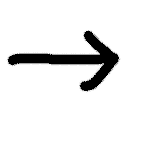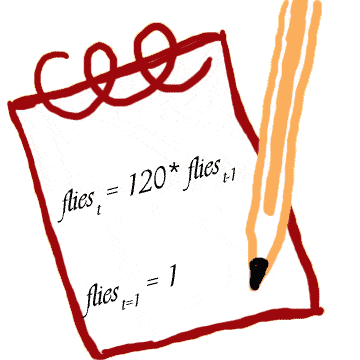Exponential growth equation
First, let's look more closely at exponential growth itself. According to exponential growth, a population is being multiplied by the same amount at each timestep. (By the way, I'm going to simplify slightly and say that flies reproduce at 120 per month rather than 120 per 2 weeks. This just makes it easier to talk about.)
 |
 |
 |
| houseflies last month | --> times 120 --> | houseflies this month |
Of course we all know that detectives need to write down clues -- and for writing down clues we need a short-hand that is not only fast, but also secret and un-understandable for the uninitiated. Mathematical terminology is perfect for that (especially the un-understandable part, you're probably thinking). So here's another version of what we have above:
The subscript (t) refers to time. So you can read left side as "flies at time t," and the right side as "flies at time t minus 1." For example, if we're talking about month 4, then t stands for 4, and the equation above reads "flies in month 4 is equal to 120 times the flies in month 3." Well, that doesn't help much unless we also know the amount of flies in month 3. And in order to know flies in month 3, we need to know flies in month 2, for which we need to know flies in month 1. Aha! Finally a question we can answer. The number of flies at the beginning is called the "initial condition". Once we know the initial condition, we can "iterate" (repeat over and over and over...) until we get up to the month we're really interested in.
Copyright University of Maryland, 2007
You may link to this site for educational purposes.
Please do not copy without permission
requests/questions/feedback email: mathbench@umd.edu
